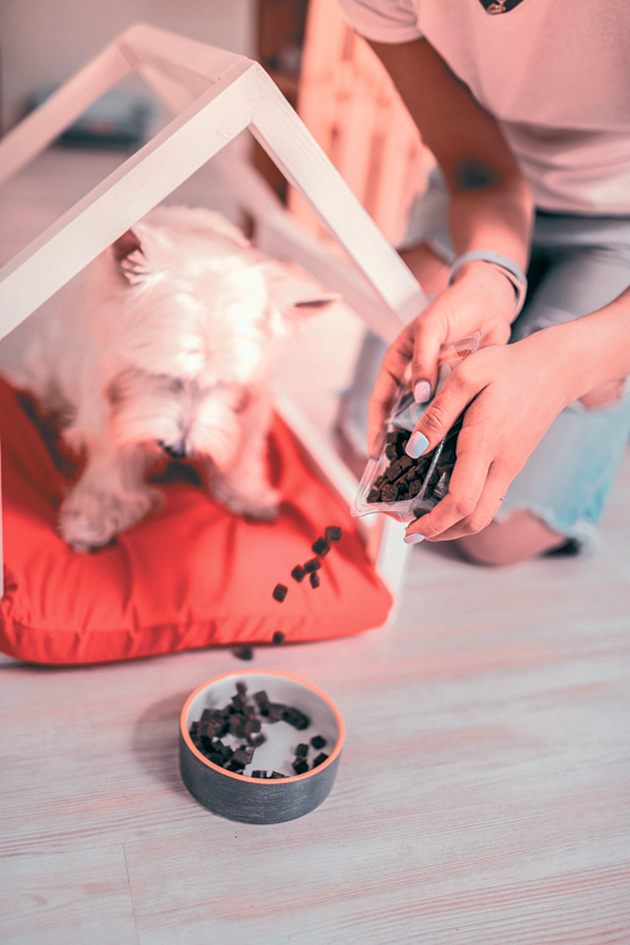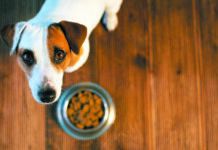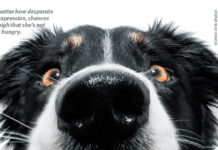How do you measure your dog’s food portions? With the bowl you happen to put her food in? With your hands? Simply by eyeballing it as you pour the kibble out of the bag? If you use any of these unreliable methods, you’re not alone. More than one out of five people participating in a study about the best way to measure dog food reported using one of these three approaches.
But even if they used a measuring cup, they got it wrong. Researchers from the Ontario Veterinary College at Canada’s University of Guelph made the point when they asked 100 people to dole out different amounts of dry dog food using a two-cup commercial food scoop, a two-cup liquid measuring cup, or a one-cup dry food measuring cup.
The results: amounts measured were off by as much as 50 percent, both under and over the amounts asked for — but much more often over than under. The smaller the volume requested, the greater the inaccuracies. Study subjects tended to be much further off trying to measure a quarter cup of kibble than a half cup or a full cup. That’s a particular problem for those with small dogs requiring small portions, the investigators say, putting them at much greater risk either for malnutrition from lack of calories or excess weight from too many calories.
Not surprisingly, the least amount of variation occurred when participants were measuring one cup of dog food with a one-cup dry food measuring cup, leading the researchers to advise that if you’re going to portion out your dog’s food by volume with a measuring cup, do so with one that holds the amount of food meant to reach the dog’s bowl; a quarter-cup measuring device for a quarter-cup serving, a half-cup scoop for a half-cup serving, and so on.
But they say the best bet of all is to use an electronic kitchen scale that weighs food in grams rather than measuring it by volume and also displays the weight digitally. That way, the number is the number. If it’s off, you can either add a little kibble or subtract some. Using a kitchen scale “is the norm in Europe,” says the head of the Tufts Animal Obesity Clinic, Deborah Linder, DVM. “Americans just don’t tend to measure that way as much because we don’t tend to have scales in our kitchens,” she says. But she adds, “I strongly recommend it, especially for small dogs.”
Granted, not all bags of dog food translate the number of cups recommended into grams, so you won’t always know how much food you’re supposed to weigh out without a conversion. One solution is to call the manufacturer for a translation. A cup of one brand of kibble may weigh a different amount than a cup from another brand because of differences in the food’s density.
But not all manufacturers know how much a cup of their food weighs, Dr. Linder says. In such cases, you need to determine how many calories your dog needs each day (your veterinarian can help with that), then look on the bag for the number of calories per kilogram and use that number to arrive at the number of grams your pet should have. Most dry dog foods contain in the neighborhood of 3,000 to 4,000 calories per kilogram, Dr. Linder says. So a dog who needs, say, 1,000 calories a day would require 0.3 to 0.4 kilogram, or in the range of 300 to 400 grams altogether. (A kilogram is 1,000 grams.)
The researchers point out that the greatest accuracy comes with measuring all the kibble a dog is supposed to eat in a day, then doling it out into the pet’s separate meals. One daily measurement simply comes with fewer opportunities to make mistakes.
This is the not the first study to indicate that measuring dog kibble by volume leads to inaccuracies. Several years ago research was published showing that apportioning dog food that way leads to underestimates of up to 18 percent and overestimates of up to 80 percent. Both that study and the current one show a greater tendency to overestimate.
Some 40 percent of American pet dogs are obese, and investing in an electronic kitchen scale in order not to overfeed can reduce the risk for diseases of excess weight, including orthopedic ills, hormonal disorders, and other serious problems.






Thank you for the info. Merry Christmas!
I would have liked to see the Feeding amount rather in Ounces than kilograms
Joey is a miniature schnauzer and is raw fed. I have always weighed his meals. He maintains his weight at 14.5 lbs. He eats three times a day and gets 4.1 ozs at each meal. This allows for training treats during the day and also special treats if I’m cooking something that is good for him. He gets weighed once a week so that I can keep track of his weight.